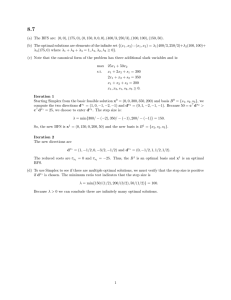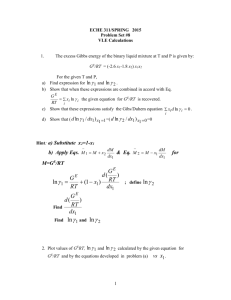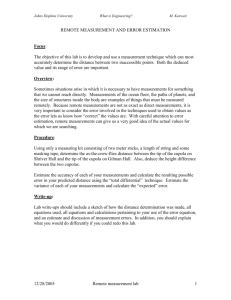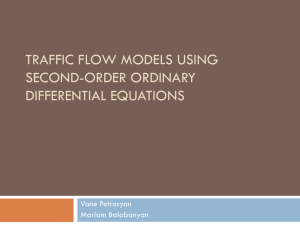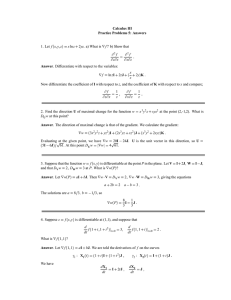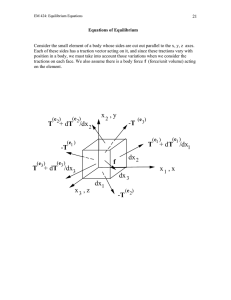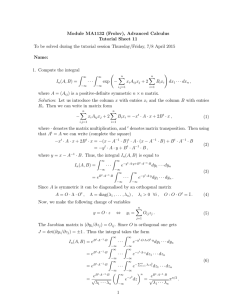Document 13475902
advertisement
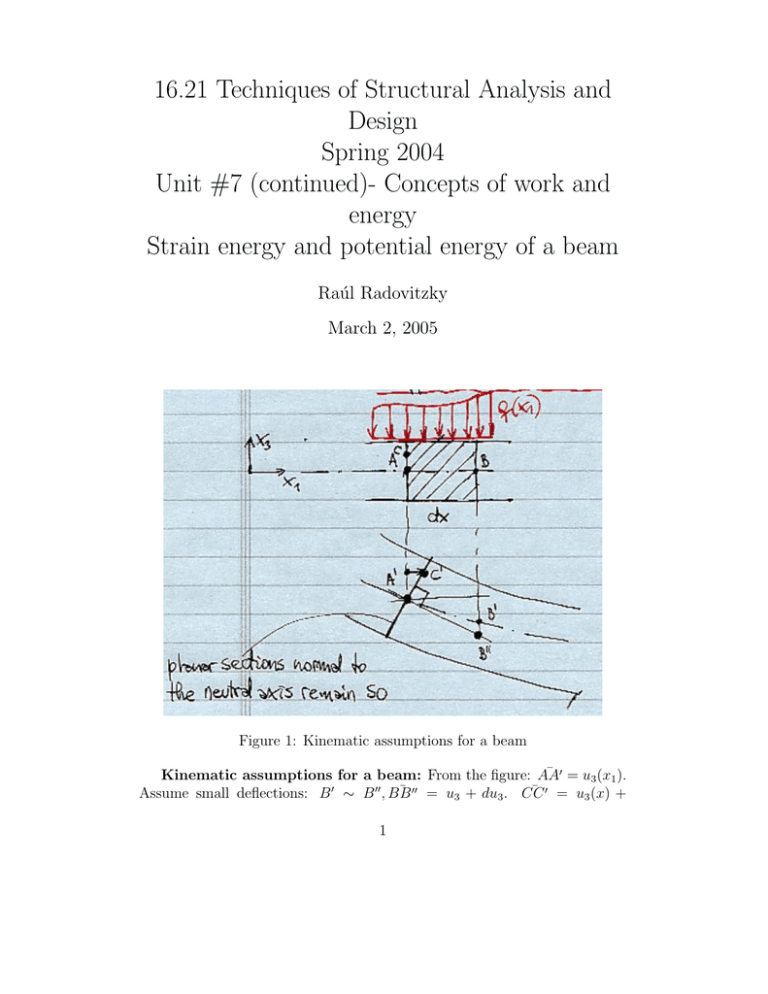
16.21 Techniques of Structural Analysis and Design Spring 2004 Unit #7 (continued)­ Concepts of work and energy Strain energy and potential energy of a beam Raúl Radovitzky March 2, 2005 Figure 1: Kinematic assumptions for a beam ¯ � = u3 (x1 ). Kinematic assumptions for a beam: From the figure: AA � �� ¯ �� = u3 + du3 . CC ¯ � = u3 (x) + Assume small deflections: B ∼ B , BB 1 u1(x1 , x3 ). Assume planar sections normal to the neutral axis remain planar after deformation. Then: u3 = u3 (x1 ) (1) du3 dx1 u3 (x1 ) is the only primary unknown of the problem u1 (x1 , x3 ) = −x3 (2) (3) From these kinematic assumptions we can derive a theory for beams. Strains: �11 = �13 du1 d2 u3 = −x3 2 dx1 dx1 (4) �22 = �33 = −ν�11 , plane stress 1 � du1 du3 � 1 � du3 du3 � = + + = − =0 2 dx1 dx1 2 dx3 dx1 (5) (6) Constitutive: σ11 = E�11 = −Ex3 d2 u3 dx21 (7) Equilibrium: Apply equilibrium (in the undeformed configuration) to in­ tegral quantities (moment M and shear force V ). Definitions of integral quantities as forces “equivalent” to the internal stresses: � V (x1 ) + σ13 dA = 0 (8) A(x1 ) � M (x1 ) + σ11 x3 dA = 0 (9) A(x1 ) replacing σ11 : � M (x1 ) = A(x1 ) � d2 u3 d2 u3 � −E 2 x23 dA = E 2 dx1 dx1 M (x1 ) = EI(x1 ) 2 d2 u3 dx21 � x23 dA A(x ) � 1�� � (10) (11) Also note: σ11 = − M x3 I (12) With these definitions we can apply equilibrium as shown in the figure: � � dV = −q dx1 Fx3 = 0 : V − qdx1 − V − dV = 0 → M B = 0 : −M + M + dM − V dx1 + q dx21 dM =0 → =V 2 dx1 d2 M d � dM � = −q → = −q dx1 dx1 dx21 (13) (14) (15) Replacing equation (11) in the last expression: d2 � d2 u3 � EI 2 + q(x1 ) = 0 dx21 dx1 (16) Fourth order differential equation governing the deflections of beams. Needs 4 boundary conditions. Examples: L x1 L x1 a) b) • case a u3 (0) = 0, u�3 (0) = 0, u��3 (L) = 0, u��� 3 (L) = 0. • case a u3 (0) = 0, u��3 (0) = 0, u3 (L) = 0, u��3 (L) = 0. 3 Strain energy of a beam Start from the general definition of strain energy density: � �ij U0 = σij d�ij (17) 0 for a linear elastic material we concluded: 1 U0 = σij �ij 2 (18) Classical beam theory: σ11 �= 0, all other stress components are zero. �11 1 1 U0 = σ11 �11 = E�211 2 2 � d2 u �2 1 d2 u3 3 = −x3 2 → U0 = Ex23 dx1 2 dx21 (19) (20) (21) 1 2 � d2 u3 �2 dV Ex3 dx21 V V 2 � � 1 L � d2 u3 �2 = E x23 dAdx1 2 0 dx21 A(x) � L � d2 u �2 1 3 U= EI(x) dx1 2 2 0 dx1 � U= � U0 dV = also note: � d2 u3 1 L U= M (x1 ) 2 dx1 2 0 dx1 Complementary strain energy of a beam Complementary strain energy density: � �11 2 1 � −M x3 �2 1 σ11 ∗ U0 = �11 dσ11 = = 2 E 2E I 0 The complementary strain energy is then � � � 1 L M2 ∗ Uc = U0 dV = x23 dAdx1 2 2 EI 0 V A(x1 ) � L 2 1 M Uc = dx1 2 0 EI Potential of the external forces: 4 (22) (23) (24) (25) (26) (27) (28) (29) � V =− � ti ui dS − S � V =− fi ui dV (30) V L q(x1 )u3 (x1 )dx1 − P u3 (L) − M u�3 (L) (31) 0 The total potential energy of the beam is: � L� � 1 � d2 u3 �2 � EI dx + qu Π(u3 ) = 1 3 + P u3 (L) + M u3 (L) 2 2 dx 0 This is the expression we gave the first day of class!. 5 (32)
